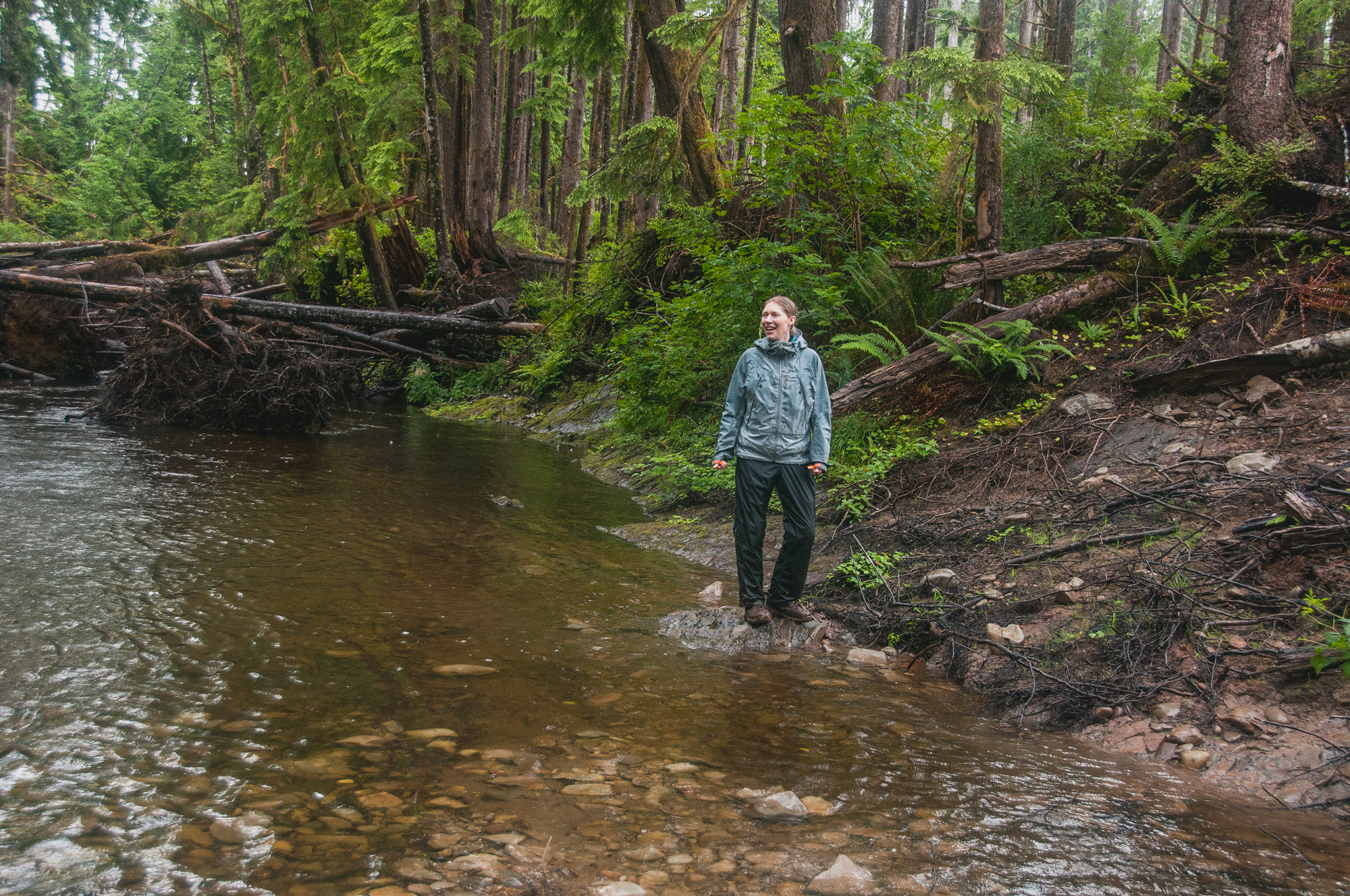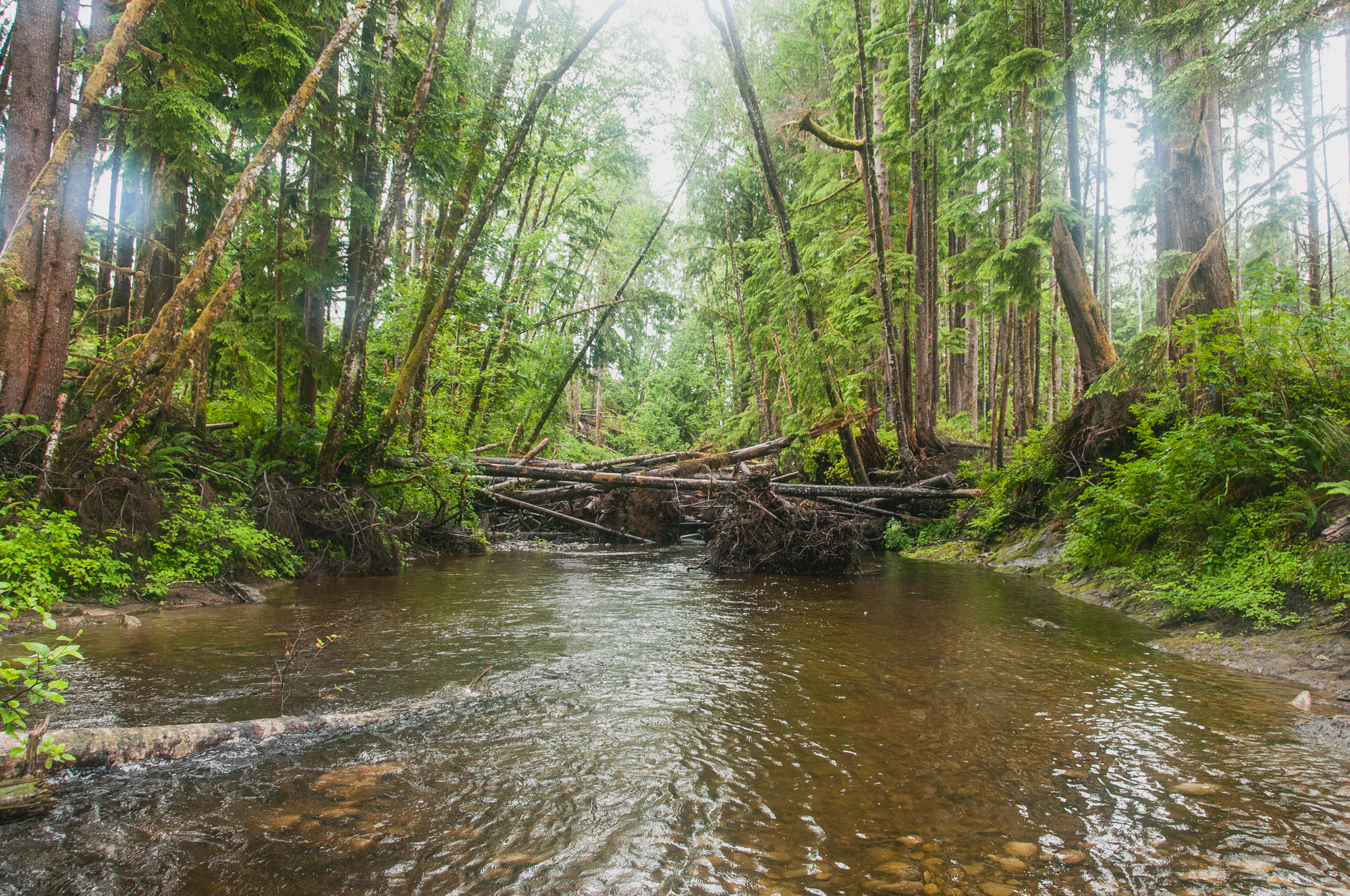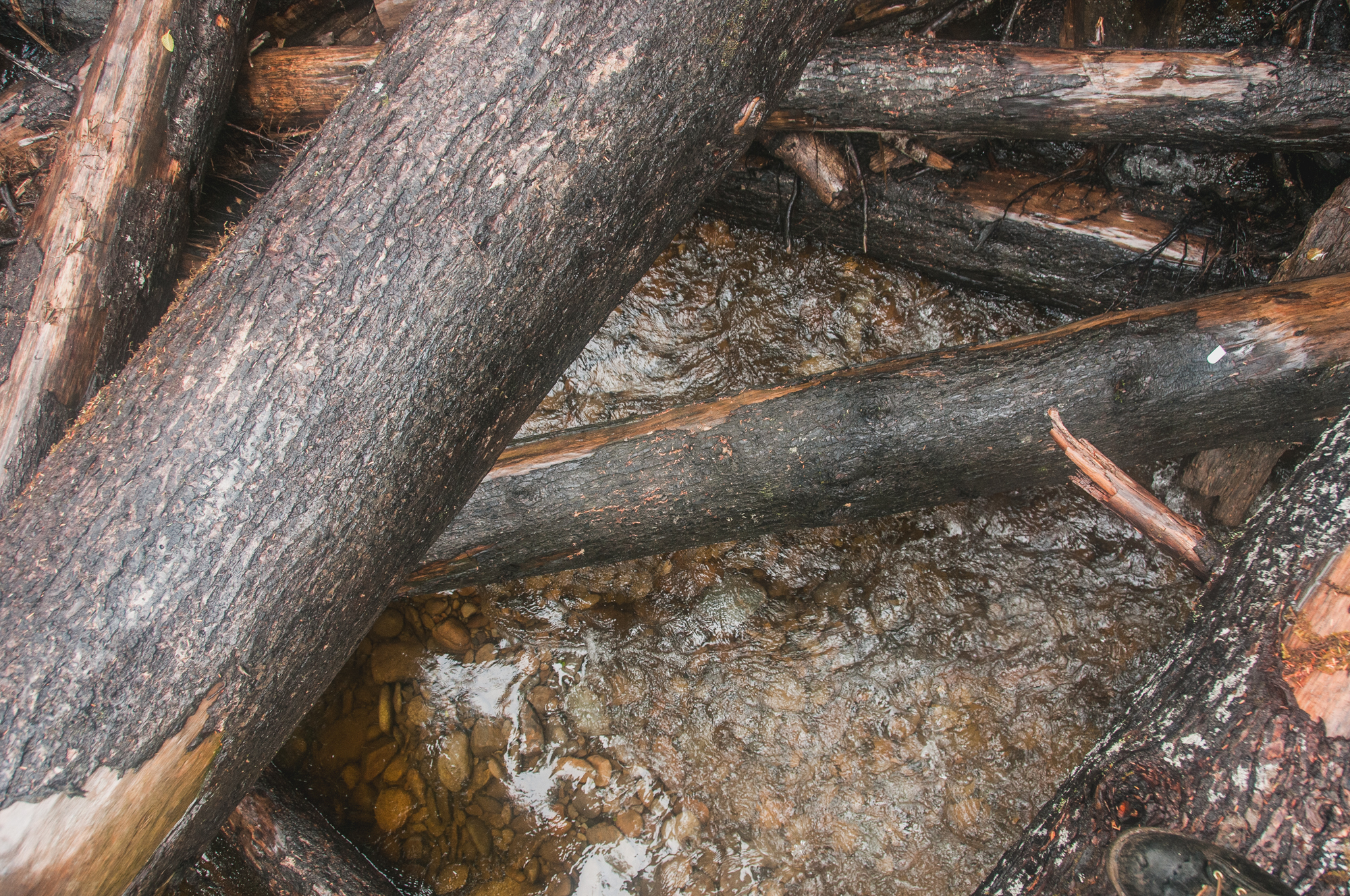Justin Urresti, Conservation Forester knows his work must take place in harmony with community members. This dynamic is especially true in the Clearwater Forest Reserve, acquired by The Nature Conservancy in 2011, as sometimes TNC appears to be opposed to industries that profit off the land. Justin’s forestry methods exist somewhere in the grey. He aims to both rehabilitate a forest that’s been logged since the late 1800s and support a local workforce within a changing economy.
Fish of the Forest: Large Wood Benefits Salmon Recovery
Written by Emily Howe, Aquatic Ecologist
Photographed by Hannah Letinich, Volunteer Photgraphy Editor
Graphics by Erica Simek-Sloniker, Visual Communications
Boots. Any aquatic ecologist worth their salt needs a collection of boots. Rubber knee boots, lug-soled hiking boots, felt-soled stream boots, chest waders, and caulks. Caulks? Before last week, a sturdy pair of spike-soled logging boots had not made my inventory list as a fisheries biologist. Flippers, yes. Wet suit booties, sure. But generally speaking, spikes are left to those scaling glaciers or trees.
My recent trip to Washington’s coastal rainforests changed my footwear paradigm.
After a 3-day four-wheel drive tour of Ellsworth Creek, the Hoh, Quinault, and Clearwater Rivers, it is clear that active forest management goes hand in hand with salmon and river recovery. Rolling back a century of damage from industrial logging requires active logging operations to thin and replant monocultural tree plantations, decommissioning and rerouting roads, and reintroducing large wood into streams and rivers. The caulks come in handy on that last one.
You see, to enhance natural river processes critical to salmon and watershed recovery, The Conservancy and its partners are reintroducing fallen trees to streams and floodplains throughout coastal Washington, Puget Sound, and the Central Cascades. This restoration technique ranks as one of the most urgent actions needed for the recovery and future resilience of salmon because it promotes a complex portfolio of aquatic habitats. Once in the water, large wood initiates log jams that in turn increase natural scour, create new pools and deepen existing ones, provide slow-water refuge for juvenile fish, create gravel beds for nesting, trap nutrients in streams, and increase food availability.
The Conservancy’s coastal forest preserves embody the integration of terrestrial and aquatic ecosystems- right down to the boots.
BRINGING BACK WILD SALMON
Bringing Back Wild Salmon
Photos and Video Recording by Kyle Smith, Washington Forest Manager
Video by Cailin Mackenzie, Globe Intern
Narration by Lauren Miheli, Volunteer Coordinator
The Nature Conservancy worked with the Quinault Indian Nation and other partners to install six engineered log jams on a tributary of the Clearwater River. Kyle Smith, our Forest Manager, relocated fish from the stream to protect them during construction. In the late 1970’s and early 1980’s, many northwest streams were completely logged – log jams restore the woody debris salmon need. This project helps reach our restoration goals for the nearly 10,000 acres of Olympic land and water we protect.
Queets Forestland Future Secured
Nature Conservancy Sells 1,720 Acres to DNR
Photograph by Bridget Besaw
WASHINGTON COAST – The Nature Conservancy has sold 1,720 acres of forestlands above the Queets River to the state Department of Natural Resources for management within the Olympic Experimental State Forest as wildlife habitat and working forest.
“This sale assures our conservation goals for this property, and supports the Conservancy’s long-term goals of a sustainable Olympic rainforest that supports wildlife and the local economy,” said David Rolph, Washington’s Director of Forest Conservation and Management for the Conservancy.
The property was part of 2,321 acres the Conservancy purchased from Rayonier in 2014. Conservancy analysis showed that the 600 acres closest to the river is most important for salmon and the health of the river system. The remaining 1,720 acres, while important upland habitat, could be managed in ways that includes sustainable forestry and some logging.
By selling to the Department of Natural Resources, the Conservancy is ensuring good long term management of the land, Rolph said. DNR owns most of the surrounding land, and their management in the Experimental Forest is governed by a 70-year federal conservation plan. It ensures strong protection of wetlands and the development of older stands of trees in the forest rotation. It also allows for continued public access and recreation, and revenue to the state school trust
“Analysis from our scientists confirms that DNR’s management under their federal conservation plan can be a good match in supporting the Conservancy’s habitat restoration goals along the Queets River system,” Rolph said.
“We’re grateful for the partnership with The Nature Conservancy in purchasing this land,” said Commissioner of Public Lands Peter Goldmark, who chairs the Board of Natural Resources, which authorized the purchase. “It will benefit future trust beneficiaries and DNR’s conservation commitments on the Olympic Peninsula.”
The sales agreement was announced in April, when the Board of Natural Resources authorized the $5.2 million purchase. The sale closed June 12. The Conservancy will use the money generated by the sale, for further forest conservation work.
The Queets is one of four major rivers flowing from the summit of the mountains in Olympic National Park to the Olympic National Marine Sanctuary in the Pacific Ocean. The Conservancy has also purchased and is restoring forest lands on the Clearwater, a tributary to the Queets, and on the Hoh River farther north. The Conservancy is also working with the Quinault Indian Nation for restoration of forests on the Quinault River.
Together with the acquisitions on the Clearwater and Hoh rivers, the Conservancy is now managing 9,410 acres of forest lands in Jefferson County. Conservancy foresters and ecologists have developed long-term plans that include planting trees, restoring important salmon and wildlife habitat, and sustainable long-rotation timber harvest where it makes sense.
Nature Conservancy Buys 3,184 Acres on Hoh River
Hoh River acquisition will help protect Olympic Peninsula
FORKS, WA- The Nature Conservancy has purchased 3,184 acres along the Hoh River near the Washington coast from Rayonier, the two organizations announced today.
The purchase is part of a Nature Conservancy initiative to increase salmon populations, promote sustainable economies and restore temperate rainforest on the Washington coast.
This $7,004,800 acquisition, which closed Monday, March 30, builds on work by the Hoh River Trust, which owns 6,800 acres along the Hoh River, to create a 32-mile conservation corridor extending from Olympic National Park to the Olympic Coast National Marine Sanctuary. Home to old-growth and temperate rain forest, the Hoh River corridor provides critical habitat for marbled murrelet, northern spotted owl, bald eagle, and bull trout. It also supports some of the healthiest native salmon and steelhead runs in the lower 48 states.
“On the Washington Coast, generations have drawn their livelihoods from a wealth of natural resources—abundant salmon and trees that grow faster than anywhere else in the world,” said Mike Stevens, Washington State Director for The Nature Conservancy. “We’re working with local communities to ensure that these wild salmon rivers and forests will continue to provide recreation and sustainable livelihoods for generations to come.”
“The Hoh River Trust is pleased to welcome The Nature Conservancy to the Hoh Valley,” said Randy Messenbrink of Forks, president of the Hoh River Trust. “Just as we have endeavored to create a restored and open land corridor we are confident The Nature Conservancy holds these shared values and bring a great synergy to the Hoh River, the Forks community and the greater West End.”
“We’re pleased to again partner with The Nature Conservancy to preserve, for future generations, this important regional forest landscape and the fish and wildlife habitat it will protect,” said David Nunes, Rayonier president and CEO. “In addition to safeguarding salmon habitat, this project connects a large forested landscape from the mountains to the sea. The responsible stewardship provided by generations of Rayonier foresters since the 1940s makes this partnership possible. I would like to thank and acknowledge the collaborative work between the Conservancy and our team for their creative and innovative approach to this transaction resulting in an economically viable agreement that will not only keep the land ecologically healthy, but also in a forestland cover.”
This acquisition is made possible with support from the Wyss Foundation, the Norcliffe Foundation, and other private donors and supporters.
“Everyone should have the chance to gaze up at the towering cedars of the Olympic Peninsula and experience the wild steelhead runs of the Hoh River,” said Hansjörg Wyss, who started the Wyss Foundation in 1998. “Thanks to the foresight and leadership of local communities, future generations will be able to hike, hunt, and explore the remarkable rainforests of the Hoh River from its source in Olympic National Park all the way to the Pacific Ocean.”
The Hoh is one of four major river systems flowing from summit to sea in the Olympic rainforest. It is expected to offer Pacific salmon and steelhead some refuge from the impacts of climate change.
The Conservancy has also purchased and is restoring forest lands on the Queets and Clearwater rivers, and is working with the Quinault Indian Nation for restoration of forests on the Quinault River. Together with the earlier acquisitions on the Queets and Clearwater rivers, the Conservancy is now managing 11,130 acres of forest lands in Jefferson County. Conservancy foresters and ecologists have developed long-term plans that include planting trees, restoring important salmon and wildlife habitat, and sustainable long-rotation timber harvest where it makes sense, said Stevens. All these activities generate jobs in coastal communities.
The Conservancy plans to maintain a forest designation and pay property taxes on this land.
Farther south on the Washington Coast, the Conservancy owns and manages nearly 8,000 acres at the Ellsworth Creek Preserve adjoining Willapa National Wildlife Refuge on Willapa Bay. The Conservancy also owns 47,921 acres of forest land in the Central Cascades east of Snoqualmie Pass.
All the Conservancy’s land on the Washington Coast continues to be open to public and tribal use for hunting, fishing, traditional gathering of plants and medicines, boating, birding, hiking, and other coastal outdoor activities.
The Nature Conservancy is a leading conservation organization working in Washington and around the world to protect the lands and waters on which all life depends. Visit The Nature Conservancy’s Washington Program on the web at washingtonnature.org.
Rayonier is a leading international land resources company primarily engaged in timberland management and the sale of real estate. Rayonier owns, leases or manages approximately 2.7 million acres of timberlands located in the U.S. and New Zealand. Rayonier is structured as a real estate investment trust. To date, Rayonier has joined with conservation experts to ensure more than 200,000 acres of forestland will remain in conservation for future generations. More information is available at www.rayonier.com.
Contact information
Robin Stanton
Media Relations/ The Nature Conservancy
(206) 436-6274
rstanton@tnc.org
Mike Bell
Public Affairs Director/ Rayonier
(904) 321-5537
mike.bell@rayonier.com































